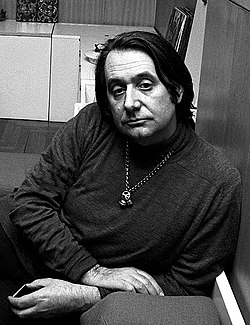Ettore Sottsass
| Ettore Michealo Sottsass | |
|---|---|

Ettore Sottsass in 1969
|
|
| Born |
14 September 1917 Innsbruck, Austria-Hungary |
| Died | 31 December 2007 (aged 90) Milan, Italy |
| Nationality | Italian |
| Occupation | Architect |
| Practice | Sottsass |
| Buildings | Mayer-Schwarz Gallery Beverly Hills, California |
| Design | Olivetti Valentine typewriter emeco.net/productline/nine-0.html Nine-0 Chair |
Ettore Sottsass (14 September 1917 – 31 December 2007) was an Italian architect and designer of the late 20th century. His body of designs included furniture, jewellery, glass, lighting and office machine design.
Sottsass was born on 14 September 1917 in Innsbruck, Austria, and grew up in Milan, where his father was an architect.
He was educated at the Politecnico di Torino in Turin and graduated in 1939 with a degree in architecture. He served in the Italian military and spent much of World War II in a concentration camp in Yugoslavia. After returning home in 1948, he set up his own architectural and industrial design studio in Milan.
In 1949 Sottsass married Fernanda Pivano, a writer, journalist, translator and critic. They divorced in 1970, and in 1976 Sottsass married Barbara Radice, an art critic.
In 1956, Ettore Sottsass began working as a design consultant for Olivetti, designing office equipment, typewriters, and furniture. Sottsass was hired by Adriano Olivetti, the founder, to work alongside his son, Roberto. There Sottsass made his name as a designer who, through colour, form and styling, managed to bring office equipment into the realm of popular culture. Sottsass, Mario Tchou, and Roberto Olivetti won the prestigious 1960 Compasso d’Oro with the Elea 9003, the first Italian mainframe computer. In 1968, the Royal College of Art in London granted Sottsass an honorary doctoral degree.
Throughout the 1960s, Sottsass travelled in the US and India and designed more products for Olivetti, culminating in the bright red plastic portable Valentine typewriter in 1970, which became a fashion accessory. Sotsass described the Valentine as "a brio among typewriters." Compared with the typical drab typewriters of the day, the Valentine was more of a design statement item than an office machine.
While continuing to design for Olivetti in the 1960s, Sottsass developed a range of objects which were expressions of his personal experiences traveling in the United States and India. These objects included large altar-like ceramic sculptures and his "Superboxes", radical sculptural gestures presented within a context of consumer product, as conceptual statement. Covered in bold and colorful, simulated custom laminates, they were precursors to Memphis, a movement which came more than a decade later. Around this time, Sottsass said: "I didn’t want to do any more consumerist products, because it was clear that the consumerist attitude was quite dangerous." The feeling that his creativity was being stifled by corporate work is documented in his 1973 essay "When I was a Very Small Boy". As a result, his work from the late 60s to the 70s was defined by experimental collaborations with younger designers such as Superstudio and Archizoom Associati, and association with the Radical movement, culminating in the foundation of Memphis at the turn of the decade.
...
Wikipedia
